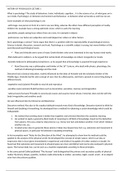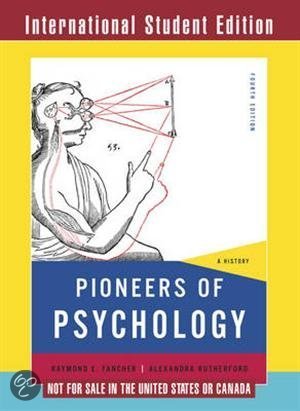HISTORY OF PSYCHOLOGY LECTURE 1
What is psychology? The study of behaviour, brain, individuals, cognition… it is the science of us, of what goes on in
our minds. Psychology is in-between environment and behaviour, so between what surrounds us and how we act.
Some examples of what psychology is are:
-self-image: one person in front of a mirror see one thing, whereas the others have different perception of reality.
Children for example have a strong optimistic vision, which is useful for learning.
-pareidolia: people seeing faces where there are none, for example in objects
-preferences: our tastes are subjective and could depend on culture or other factors
But is psychology a science? Some argue that there is a problem with the reproducibility of psychological science.
Science is doubt, discussion, research and trust. Psychology as a scientific subject is young, but many thinkers of the
past discussed psychological issues.
Plato and Aristotle were some of many Greek thinkers who were interested in the way human mind works:
-Plato believed in nativism, so he argued that certain kinds of knowledge are inborn (congenito) or innate
-Aristotle believed in philosophical empiricism, so he argued that all knowledge is acquired through experience
René Descartes was a philosopher and thinker of the 16 th Century, who dealt with physics, physiology, the
method of obtaining knowledge and the mind.
Descartes had a classical education, mainly influenced by the ideas of Aristotle and the scholastic thinker of the
Middle Ages. Aristotle had his own concept of soul, that he called psyche, and that is present in every living being in
different levels.
-vegetative souls (plants)enable to nourish and reproduce
-sensitive souls (animals)add functions such as locomotion, sensation, memory and imagination
-rational souls (humans)enable to consciously reason and assume moral virtues; immortal, does not die with the
body (≠vegetative and sensitive souls)
He was influenced also by Mersenne and Beeckman.
Descartes method: Also due to his sceptical attitude towards every kind of knowledge, Descartes started to think for
himself and doubting of everything. He developed then a method for obtaining a certain knowledge which could be
indisputable.
1. He realised that working alone is better than together and criticised therefore the academic learning.
2. He wanted to apply a geometry-liked mode of reasoning to all fields of knowledge, based on the deduction
from axioms. This was a step by step process; e.g. I know one fact and deduce another, from which I deduce
another one, ecc.
3. Created some rules to generate these axioms (=ideas true beyond any fact; e.g. extension and movement in
physical space), in particular he believed in doubting everything
In his incomplete work “Rules for the Direction of the Mind”, he attempted to show how his method could be
applied to the analysis of the physical world. He developed the concept of simple nature, which is an idea or
impression that is clear (given immediately in experience) and distinct (incapable of further analysis or doubt). He
found out that extension and movement in physical space are clear and distinct and can be also analysed in physical
space. The human body too, can be seen as a machine explainable according to these principles.
In the same period Galilei published “The Assayer” and distinguished the primary and secondary quality of physical
matterprimary (shape, quantity, motion) reside inherently in matter; secondary (sight, sound, smell… of an object)
arise from the primary qualities.
,“Treatise of Light” present Descartes physical ideas based on the analysis of material particles in motion. He believed
the entire universe was filled with different kind of material particles in different kind of motion (no empty space).
He categorised 3 types of particles:
-fire or heat particles: so tiny that when aggregated constituted a virtually perfect fluid capable of filling up space of
any shape and size. They form the sun in the centre of universe
-air particles: still tiny, numerous, fulfilled the spaces among objects
-earth particles: heavy, constituted all material objects (planets, comets, objects)
Then he explains the various phenomena of light. He argued that air particles form columns between objects,
forming the material basis of light rays; therefore when we look at a certain object, many light rays or columns of air
particles extend between the object and our eye. Furthermore earth particles are in constant vibratory motion and
transmit these vibration to the light rays columns and therefore to the eye. Vibrations stimulate the material
particles of the eye in sympathetic motion, which give us the physical basis for the perception of light. e.g. blind
man with a stick; stick=light ray: transmit the motion of a stimulus from the object to the hand/eye. This implied that
light speed is instantaneous (this theory will be discredited later on).
Descartes also dealt with mechanistic physiology and tried to explain that the body can be seen as a machine and
can therefore be scientifically studied.
For him the body has ten physiological functions: digestion of food, circulation of blood, nourishment and growth of
the body, respiration, sleeping and waking, sensation of the external world, imagination, memory, appetites and
passions and movements of the body. All these functions occurred mechanically. This idea of humans was the basis
for the development of neuropsychology.
Descartes was interested in the brain’s internal cavities (=ventricles) filled with what he called animal spirit, known
today as cerebrospinal fluid (CSF), which he thought to be composed by the tiniest particles present on earth. He
further adopt Galen’s idea and started to think that nerves are hollow tubes where the cerebrospinal fluid can pass
and, as a pump, activate muscles. He saw the brain as a system of tubes and valves, which can direct animal spirits
into specific nerves, and therefore initiate specific actions. He argued that this mechanism of tubes and valves was
regulated by the external stimulus given by the movements of particles, which was perceived by nerves and
transmitted to the brain. This theory is really similar to what today we called reflex, a neurophysiological sequence in
which a specific stimulus from the external world automatically provokes a specific response in the organism.
He conceived two kinds of reflexive response:
-automatic reflex: vital spirits flow immediately down the same nerve whose fibers have been stimulated, resulting
in an immediate and automatic response (e.g. when a person’s feet is next to the fire, the particles stimulate the
skin, pulling a nervous fiber, which tugs the brain and cause the animal spirit to flow down the nerves, which cause
the muscles of the feet to move)
-learned reaction: the response is not originally connected with its stimulus, which means that incoming stimulus can
activate the opening of nerves different by the one stimulated.
People and animals do not always react in the same way to the same stimuli. Internal factors such as emotions
create currents (commotions) in animal spirit reservoir (serbatoi) which influence the receptiveness of nearby
nerves. The response of body to certain stimuli occurs because of the interaction between external stimulation on
the nervous system and internal preparedness of the animal spirit to respond in particular ways.
For the same principle an alert waking state is caused by the presence of much animal spirit, which cause brain
tissue to expand, pulling the nerves fibers to a state of maximal reaction to the external stimuli. By contrast, the
sleeping brain miss most part of animal spirit and therefore fibers are not able to respond to stimuli. However
sometimes during sleep dreams occur, due to random eddies in the animal spirit, which cause isolated part of the
brain to expand and pull a few nerve fibers.
, He therefore replaced the Aristotelian vision of the vegetative and animal soul through a mechanistic vision, but
could not get rid of the rational soul, as humans are often conscious of their action and have the will to act in a
certain way . He therefore believed that animals could be completely understood in mechanistic terms.
In his book “Discourse of method”, Descartes describes his attempts at systematically doubting of everything. At first
everything seemed to be doubtable, as every experience could actually be an illusion. However this led him to
understand that he could not doubt the subjective reality of his own doubting mind, which means that he could not
doubt the activity of his own rational mind cogito ergo sum= I think therefore I am
He therefore realised that thinking is a special activity beyond the body, that does not consist of particles and does
not occupy any space. Some ideas such as perfection, unity or infinity are innate ideas of the soul, as they do not
derive from a single sensory experience, even if they are real. This is the so called dualism, which means that body
and mind are separated, but many phenomena are the result of an interaction between these two.
Descartes is therefore a rationalist, since he appealed to intellectual and deductive reason (as opposed to sensory
experience or any religious teachings) as the source of knowledge or justification, a nativist, as he believed that some
ideas existed prior to concrete experience (≠empiricist: sensory perceptionideas) and a dualist.
Descartes also argued that these interaction between the body and the mind could be localised in the only undivided
structure he could find in the brain: the pineal gland. Furthermore he advanced the idea of passions, conscious
experience accompanying the body’s emotions. When emotions cause eddies in the animal spirit, it touches the
pineal gland, which cause the soul to respond to the stimulus in two ways: first the soul has conscious sensation of
the passion and second it may attempt to influence this passion by moving the pineal gland, which enhances or limits
the emotional movements of the animal spirit. He chose the pineal gland, because it seemed the only part of the
body not to be double, but single and therefore perfect.
The soul was rational, consisted and unified, but often could not rule over the body, creating a sort of conflict
between them. This is the essence of human condition.
This idea was inspired by the simple question of his royal friend Elisabeth of Bohemia, who asked how does the
immaterial soul interact with the material body. Even though he explained where there is interaction, he did not
explain how.
However with his dualism Descartes exceeded the old idea of homunculus, a small man in the head of every human
that guides his actions, replacing it with the concept of soul.
Influences:
-brain=most important individual organ in the mediation of behaviour
-reflex=stimulus-response sequence mediated by the nervous system
-innate and acquired reflexes theory led to behaviourism
-humans= creature in conflict (Freud)
-Locke, Leibniz
LECTURE 2
Psychology comes from the combination of philosophy and the study of:
-physiology: how the body influences the mind (neurons and brain)
-evolution: why we are what we are, Darwin’s theoriesthe mind has a function
-statistics: physiological laws can be derived from the observation of groups of people
Dualism (mind separated from the body) vs. materialism (mind is a product of the body)
Positive sides of dualism: relates toexperience (self, consciousness), lay theories, religion, free will






